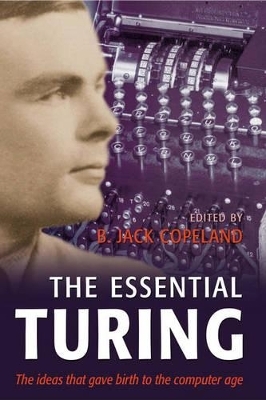
The Essential Turing
Clarendon Press (Verlag)
978-0-19-825079-1 (ISBN)
Alan Turing was one of the most influential thinkers of the 20th cwentury. In 1935, aged 22, he developed the mathematicl theory which explained what computers would and would not be able to do. All subsequent computer design was modelled on this work. At the outbreak of hostilities with Germany in September 1939, he hoined the Goverment Codebreaking team at Bletchley Park, Buckinghamshire and played a crucial part in deciphering the Engima code. After the war, his theoretical work was turned into reality as he developed Britain's first computers at the National Physical Laboratory and the Royal Society Computing Machine Laboratory at Manchester University. Turing also worked extensively on the study of how the mind operates. He was a founding father of modern cognitive science and pioneered the concept of Artifical Intelligence. He developed the use of computers to model biological growth, launching the discipline now referred to as Artificial Life. The papers in this book are the key works for understanding Turing's phenomenal contribution across all these fields.
The collection includes Turing's declassified wartime "Treatise on the Enigma"; letters from Turing to Churchill and to codebreakers; lectures, papers and broadcasts which opened up the concept of AI and its implications; and the paper which formed the genesis of the investigation of Artifical Life.
B. J. Copeland is Reader in Philosophy at the University of Canterbury, New Zealand.
Alan Turing 1912-1954 ; Computable Numbers: A Guide ; 1. On Computable Numbers, with an Application to the Entscheidensproblem (1936) ; 2. On Computable Numbers: Corrections and Critiques ; 3. Systems of Logic Based on Ordinals (1938) ; 4. Letters on Logic to Max Newman (c. 1940) ; Enigma ; 5. History of Hut 8 to December 1941 (1845) ; 6. Bombe and Spider (1940) ; 7. Letter to Winston Churchill (1941) ; 8. Memorandum to OP-20-G on Naval Enigma (c. 1941) ; Artificial Intelligence ; 9. Lecture on the Automatic Computing Machine (1947) ; 10. Intelligent Machinery (1948) ; 11. Computing Machinery and Intelligence (1950) ; 12. Intelligent Machinery, A Heretical Theory (c. 1951) ; 13. Can Digital Computers Think? ; 14. Can Automatic Calculating Machines Be Said to Think? (1952) ; Artificial Life ; 15. The Chemical Basis of Morphogenesis (1952) ; 16. Chess (1953) ; 17. Solvable and Unsolvable Problems (1954)
| Erscheint lt. Verlag | 9.9.2004 |
|---|---|
| Zusatzinfo | numerous line drawings and halftones |
| Verlagsort | Oxford |
| Sprache | englisch |
| Maße | 163 x 242 mm |
| Gewicht | 1 g |
| Themenwelt | Geisteswissenschaften ► Psychologie ► Allgemeine Psychologie |
| Geisteswissenschaften ► Psychologie ► Verhaltenstherapie | |
| Informatik ► Grafik / Design ► Digitale Bildverarbeitung | |
| Informatik ► Theorie / Studium ► Künstliche Intelligenz / Robotik | |
| ISBN-10 | 0-19-825079-7 / 0198250797 |
| ISBN-13 | 978-0-19-825079-1 / 9780198250791 |
| Zustand | Neuware |
| Haben Sie eine Frage zum Produkt? |
aus dem Bereich


